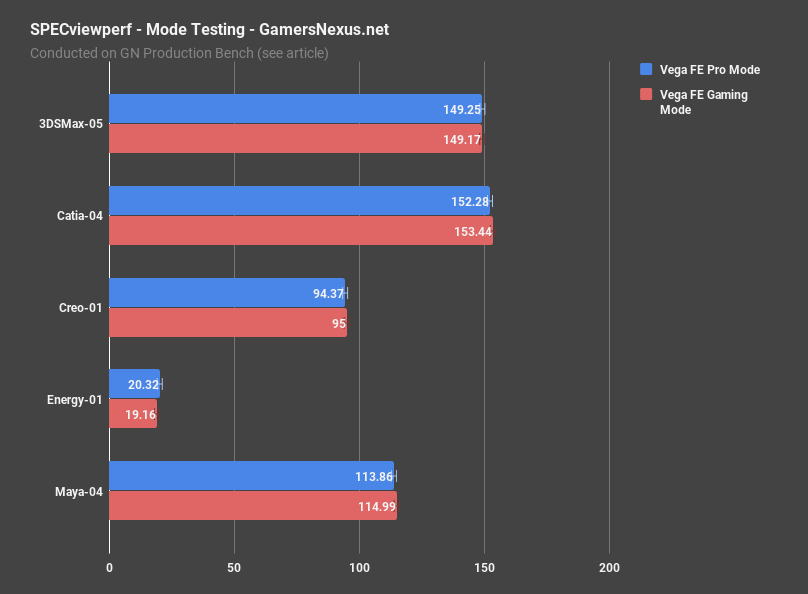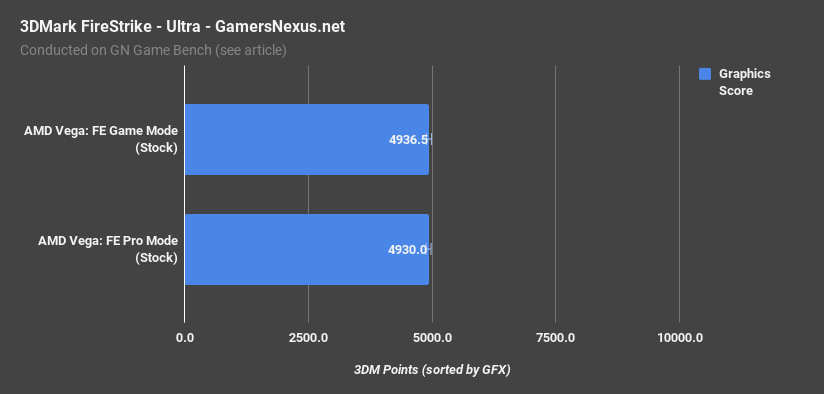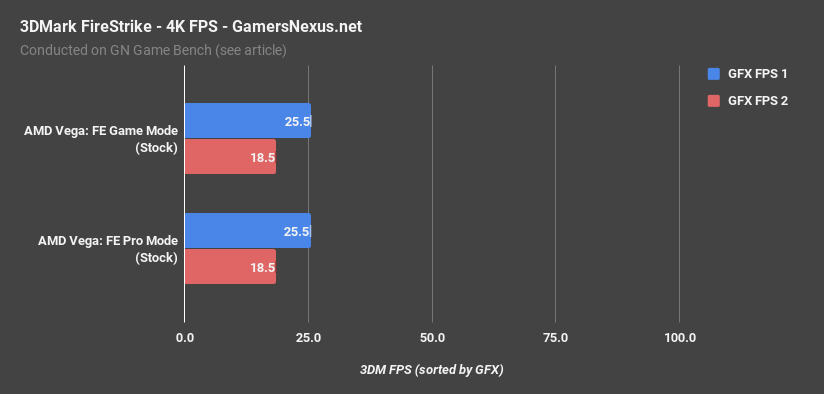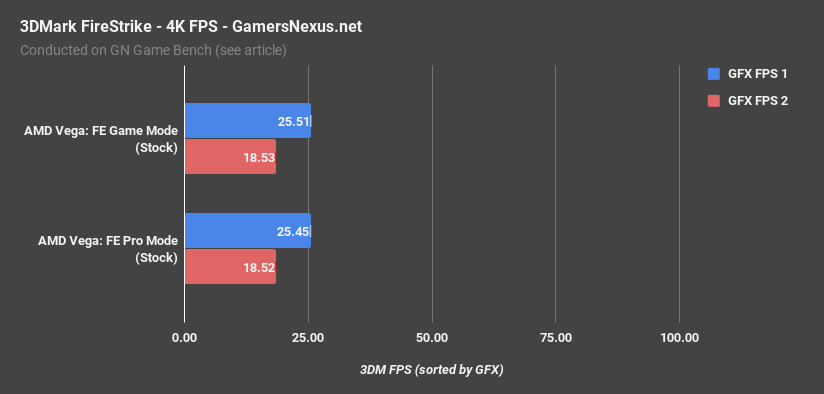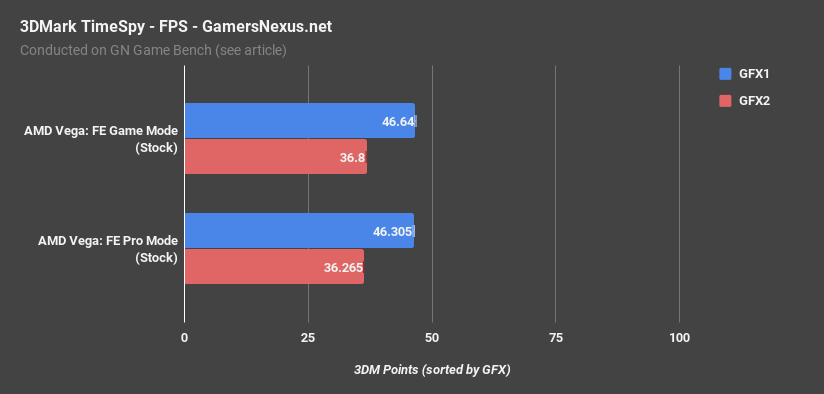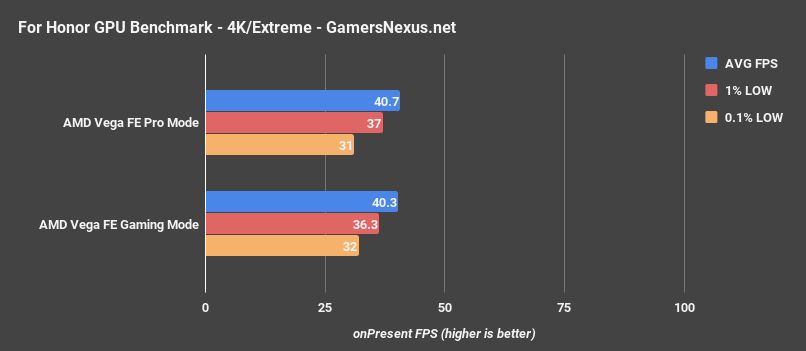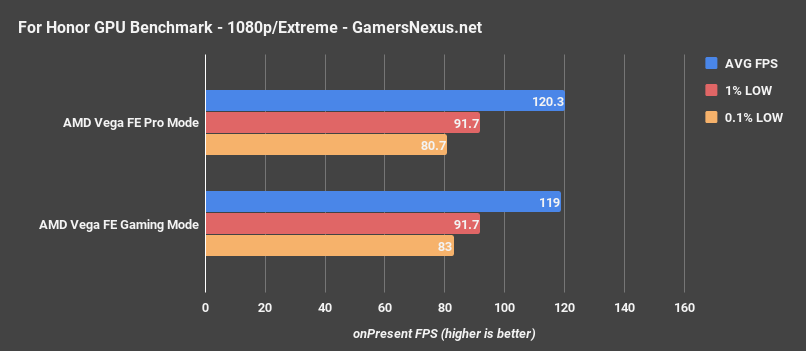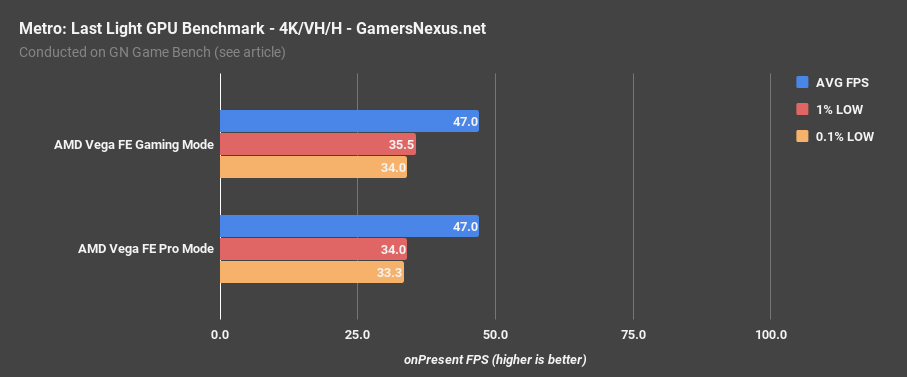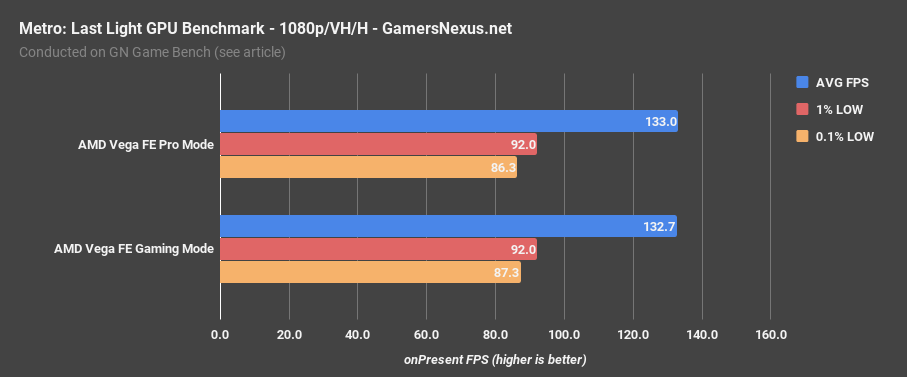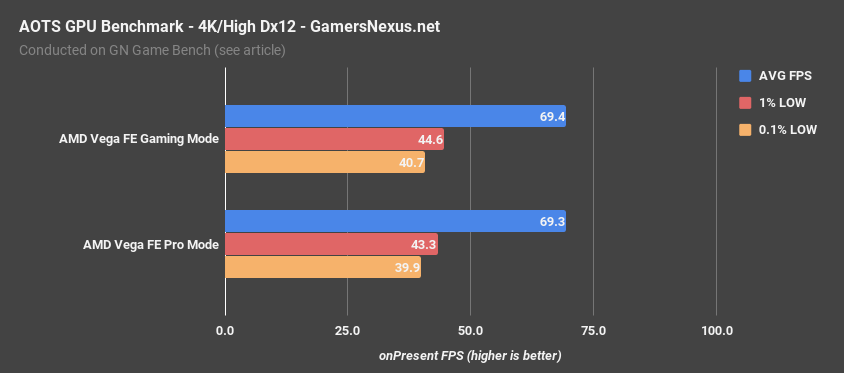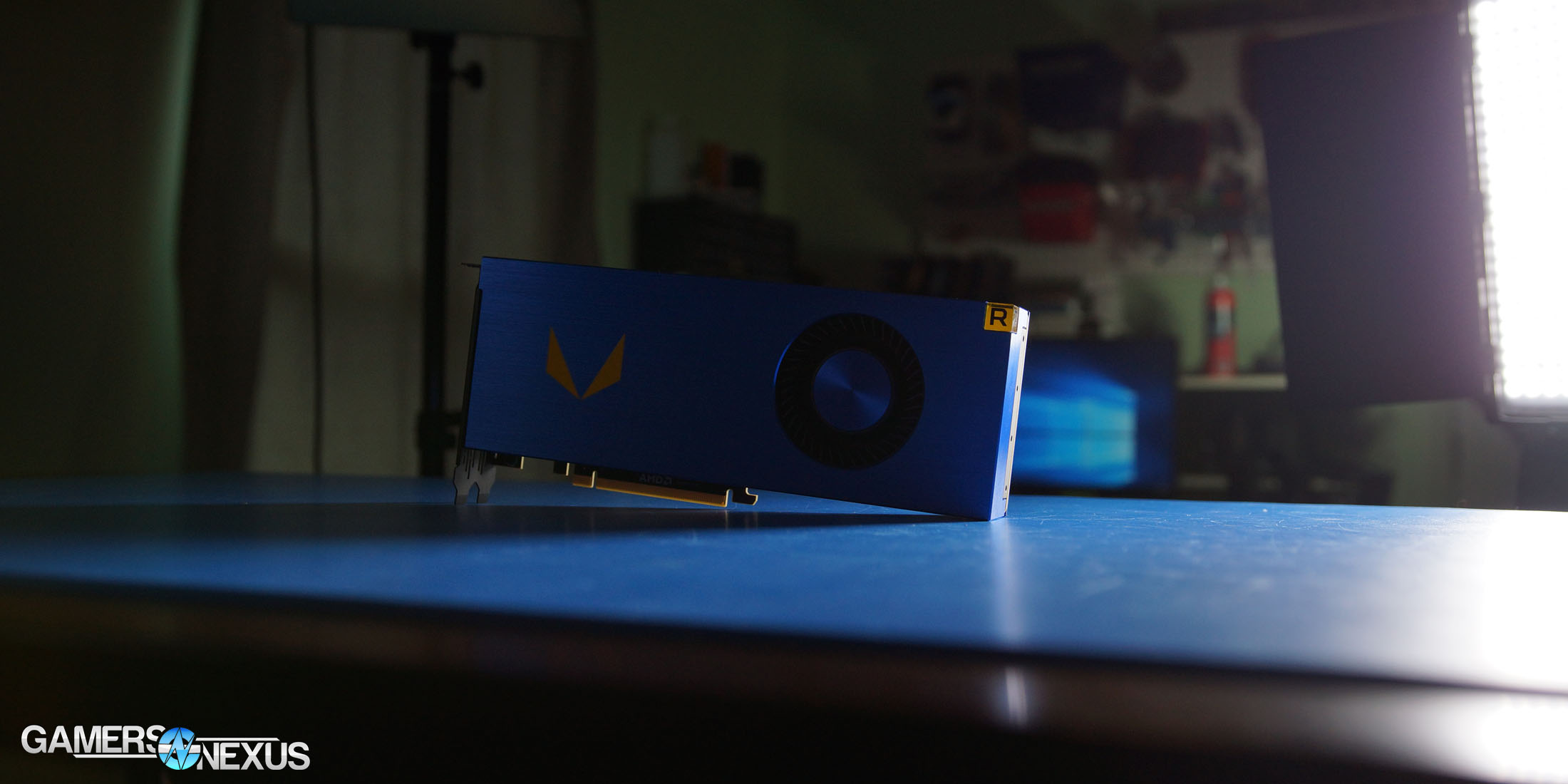We’ve already endured one launch of questionable competence this quarter, looking at X299 and Intel’s KBL-X series, and we nearly escaped Q2 without another. Vega: Frontier Edition has its ups and downs – many of which we’ll discuss in a feature piece next week – but we’re still learning about its quirks. “Gaming Mode” and “Pro Mode” toggling is one of those quirks; leading into this article, it was our understanding – from both AMD representatives and from AMD marketing – that the switch would hold a relevant impact on performance. For this reason, we benchmarked for our review in the “appropriate” mode for each test: Professional applications used pro mode, like SPECviewperf and Blender. Gaming applications used, well, gaming mode. Easy enough, and we figured that was a necessary methodological step to ensure data accuracy to the card’s best abilities.
Turns out, there wasn’t much point.
A quick note, here: The immediate difference when switching to “Gaming Mode” is that WattMan, with all its bugginess, becomes available. Pro Mode does not support WattMan, though you can still overclock through third-party tools – and probably should, anyway, seeing as WattMan presently downclocks memory to Fury X speeds, as it seems to have some leftover code from the Fury X drivers.
That’s the big difference. Aside from WattMan, Gaming Mode technically also offers AMD Chill, something that Pro Mode doesn’t offer a button to use. Other than these interface changes, the implicit, hidden change would be an impact to gaming or to production performance.
Let’s briefly get into that.
Game Bench
| GN Test Bench 2017 | Name | Courtesy Of | Cost |
| Video Card | This is what we're testing | - | - |
| CPU | Intel i7-7700K 4.5GHz locked | GamersNexus | $330 |
| Memory | GSkill Trident Z 3200MHz C14 | Gskill | - |
| Motherboard | Gigabyte Aorus Gaming 7 Z270X | Gigabyte | $240 |
| Power Supply | NZXT 1200W HALE90 V2 | NZXT | $300 |
| SSD | Plextor M7V Crucial 1TB | GamersNexus | - |
| Case | Top Deck Tech Station | GamersNexus | $250 |
| CPU Cooler | Asetek 570LC | Asetek | - |
BIOS settings include C-states completely disabled with the CPU locked to 4.5GHz at 1.32 vCore. Memory is at XMP1.
We communicated with both AMD and nVidia about the new titles on the bench, and gave each company the opportunity to ‘vote’ for a title they’d like to see us add. We figure this will help even out some of the game biases that exist. AMD doesn’t make a big showing today, but will soon. We are testing:
- Ghost Recon: Wildlands (built-in bench, Very High; recommended by nVidia)
- Sniper Elite 4 (High, Async, Dx12; recommended by AMD)
- For Honor (Extreme, manual bench as built-in is unrealistically abusive)
- Ashes of the Singularity (GPU-focused, High, Dx12)
- DOOM (Vulkan, Ultra, 0xAA, Async)
Synthetics:
- 3DMark FireStrike
- 3DMark FireStrike Extreme
- 3DMark FireStrike Ultra
- 3DMark TimeSpy
For measurement tools, we’re using PresentMon for Dx12/Vulkan titles and FRAPS for Dx11 titles. OnPresent is the preferred output for us, which is then fed through our own script to calculate 1% low and 0.1% low metrics (defined here).
Power testing is taken at the wall. One case fan is connected, both SSDs, and the system is otherwise left in the "Game Bench" configuration.
For production testing, we are using an i9-7900X & ASUS X299 Prime Deluxe motherboard with 4x8GB GSkill Trident Z Black memory at 3600MHz with an Enermax Platimax 1350W PSU.
Note: These tests will not include other benchmark numbers aside from Vega: FE. That's not the point of the test. For comparative analysis, please see our Vega: FE review.
SPECviewperf – AMD Vega: FE Pro Mode vs. Gaming Mode
Starting with production first, as that’s easiest to demonstrate, we end up with the numbers on the chart below. Notice that there are some error bars there which indicate the range of test-to-test variance. Taking these into account, everything is effectively equal. There is no clear performance leader in either mode, and there is no pattern to which mode holds the marginal, within-error differences. This means that all the tests are within test-to-test variance, and can be declared “effectively equal.”
That was easy. Let’s get to FireStrike.
FireStrike – AMD Vega: FE Pro Mode vs. Gaming Mode
With FireStrike Ultra, the difference is 6.5 points in the graphics score – or 0.1%. We’re at 4936.5 points after 5 averaged, automated runs for the Gaming Mode card and 4930 points after 5 averaged runs for the Pro Mode card. If we look at that represented as FPS, the difference is even less significant – it’s 0%. We’re at 25.5 vs. 25.5 for GFX FPS1 and 18.5 vs. 18.5 for GFX FPS2.
Let’s update the charge to include 2 significant figures.
There’s the difference: 25.51 vs. 25.45 and 18.53 vs. 18.52.
Well, that’s unexciting.
Next chart: with TimeSpy, we’re seeing a difference in FPS of 0.335 FPS for GFX1 and 0.535FPS in GFX2, after 5 averaged test passes. These two are identical in performance.
FireStrike Extreme and FireStrike’s normal benchmarks are pretty boring, as they show the same results. We’ll move on to games – no point in showing a bunch of numbers that are identical.
For Honor – Gaming vs. Pro Mode (Vega: FE)
With For Honor at 4K and with Extreme settings, we’re seeing a performance difference of 0.7FPS AVG, and less than 1FPS in our frametime representative values. The frametimes and the framerate are all the same here.
For Honor at 1080p is also the same, where we see differences of around 1FPS at most between Pro and Gaming modes.
Metro: Last Light – Gaming vs. Pro Mode (Vega: FE)
Metro: Last Light at 4K posts a difference of 0 FPS average. We’re at 47FPS on both devices, with lows basically the same.
1080p is the same – less than 1FPS difference between the modes.
Ashes of the Singularity (Dx12) – Gaming vs. Pro Mode
Finally, Ashes of the Singularity with Dx12 shows more of the same – our numbers are basically tied here. There is no significant difference between the two driver modes.
Squandering an Opportunity
We have more data, but it’s really pointless to put it together – it’ll save us time on charts and save you time on reading: Everything is the same. Sniper, GTA, Battlefield, Ghost Recon – all the same.
AMD has shipped a driver package with a psychological switch: Toggling from “gaming” to “pro” mode results in nothing aside from a black flicker and the obfuscation of WattMan – an already broken option – and Chill, of arguable merit to begin with. This toggle is built to make you feel like the GPU is doing something better, but it’s actually not; the performance is exactly the same between modes, and the only change is that “pro” users cannot see the buggy mess that is WattMan. Perhaps that’s the benefit.
Perhaps there’s a planned difference in clock if the card weren’t already ramming headlong into a power limitation, but clocks can’t even maintain 1600MHz consistently right now. And besides, there's no current difference in clocks, anyway. If the goal is to modify clock under FE Air’s parameters, it’s an unachievable one in our testing -- and it's not present in the launch driver package.
And so we’re left with an oddity in the drivers that seemingly serves as AMD’s glue for this enigmatic card: “It’s not a gaming card,” we hear, but AMD itself bills this device as a hybrid between professional workloads (with more focus on pro applications) and gaming. The idea is that a professional user, like a game developer, could switch into “game mode” to play-test their creation. This is supposed to be the adhesive, but it’s just a gimmick. In the current state of the drivers, there is no functional value to this switch.
If this is AMD’s end-game for the driver, it’s a sad, pointless gimmick. If it’s not the end-game, and if AMD actually hoped to do something of value with the Gaming/Pro switch, then the drivers are woefully incomplete – more so than is already apparent.
AMD still has a chance with this product line. Our initial review didn’t share much of an opinion – just data – and we saw that Vega: FE showed promise in some very specific production applications.
Screaming “it’s not a gaming card!” from the front page of the internet doesn’t change the fact that, in actuality, AMD does intend for Vega: FE to sit wedged between gaming and production. This is something the company has confirmed with GamersNexus. It also does not change the fact that the card clearly exhibits driver inadequacies, and it is not on the press to “wait” to review an incomplete product – it’s on the company to ship a complete device which is representative of its marketing. We agree, and have published, that this is not a device best used for gaming. We’re not saying it is a gaming device, and have shown some production workloads where Vega: FE does well. What we’re saying is that, having now spent a week on various aspects of this device, giving AMD a free pass by repeatedly copying and pasting “it’s not a gaming card” into comment boxes isn’t going to encourage the company to fix its inadequacies. The drivers are inadequate to an extent that makes it difficult to tell whether the hardware is any good.
AMD did not respond to a request for comment prior to the writing and publication of this article.
Stay tuned for more coverage.
Editorial: Steve Burke
Video: Andrew Coleman
